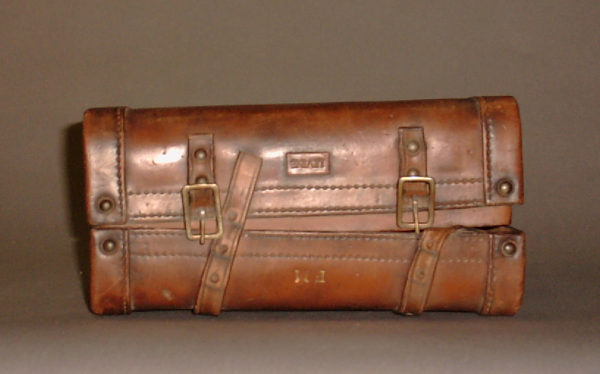
Marilyn Levine, F.M. Case, 1981, stoneware, glazed, 4 3/4 in. x 9 3/8 in. x 8 in., gift of Mr. and Mrs. Fred Marer, Scripps College
The Ceramic Comedy
Comparing ceramicist Marilyn Levine—who, over the course of 35 years used clay to imitate the form and texture of leather goods—to stand-up comedian George Carlin may at first seem unexpected, but both imbue their art with a working class humor, looking at the mundane and the elite in a wry, chuckling way.
Stand-up comedy has always been associated with blue-collar roots; it is often seen as a non-art developed for vaudeville or seedy clubs, and ceramics likewise has been often demoted from art to craft. But, like Carlin and Richard Pryor in the 1960s, who made stand-up socially relevant and technically sophisticated, the California Clay Movement of the 1950s, spearheaded by Levine’s mentor Peter Voulkos, legitimized the medium as fine art. It is Levine’s triumph then to not only match the technical and conceptual prowess of that generation, but to inject humor and mundaneness associated into a field newly deemed as a serious art form.
In her Los Angeles Times obituary, Levine is described as an “artist/trickster,” and F.M. Case well represents her particular type of art/trick. Her genre, trompe l’oeil, French for “to deceive the eye,” is often associated with the sight gag—Wile E. Coyote painting pristine landscapes in an attempt to catch the Road Runner is one example. In Levine’s F.M. Case, paint is not meant to simulate scenery, but rather the work fools the viewer into mistaking fired clay for leather.
One of the sad parts about this essay is that the work cannot play with the viewer as it might in a physical gallery. Identified via caption as a ceramic, it cannot fool the reader here. But in a gallery space, the object reveals itself slowly with the same build-up as a good joke. Levine evokes both the leather texture of the case and the brass of the snap fasteners, even mimicking the slight sheen that worn-down leather has. From a distance, the work looks no different from works of “found art” popular during the 1970s when Levine got her start. Moreover, her facsimiles are near perfect, down to the weight. The clay is light enough that, should one have the opportunity to hold the artwork, it still fools the hand as much as the eye; it feels like a case. If it could only unfasten, it would be quite a fashionable one at that.
The work consciously mimics trompe l’oeil, an artistic form meant to rebel against representation and the confines of the gallery space. Even before the prank is revealed, a sly humor surrounds it. From afar, it looks nothing like a ceramic, and if exhibited among the monumental ceramic sculptures popular in the California Clay Movement, its outsider nature would draw attention from across the room, luring in those fascinated by something so diminutive hiding among massive peers.
Even as one approaches, the true nature of the object does not necessarily reveal itself. Levine replicates the stitch work in exacting detail. A viewer can easily identify the leather and the brass work as glaze upon close inspection, but the skill necessary to copy thread and stitching is almost unbelievable. Levine’s talent as a miniaturist rivals her ability as a humorist: her needlework is particularly remarkable. Only through detailed examination, or the aid of a wall text or tour guide, can one discover its true nature. The revelation at once prompts embarrassment at being wrong, a bargaining disbelief that makes viewers try (in vain) to prove that it cannot be clay. Joy from the prank follows, and marvel at the technical sophistication ends the experience.
Like any great joke, though, the work also critiques the society that produced it. The legacy of the California Clay Movement has privileged large scale, non-functional works in ceramics shows. By 1983, when this piece was produced, three decades after the California Ceramics Movement and two decades after the start of Levine’s experiments with leather-like clay, ceramics had become increasingly divorced from its original purpose as a medium for functional objects. By marrying clay to leather, a medium firmly planted within the craft tradition, and producing a facsimile of such a commonplace object, Levine reincorporates the utilitarian into clay. Certainly, this case is without everyday use, but neither are the monumental works of Levine’s peers. By placing a utilitarian object into a gallery, Levine’s case really does take after the found art movement: it showcases how much high art in the 80s had divorced itself from the common lives of working and middle class people.
For all of this talk of criticism of art trends, one shouldn’t lose focus on the humor. This clay case has a wacky, pop-art sensibility, similar to Jeff Koons’s balloon dogs made of metal. Levine does more than trick and fool; she makes clay as intimate and relatable to the viewer as a joke from a good friend.
David Kuhio Ahia, PO ’18
Getty Multicultural Undergraduate Intern

